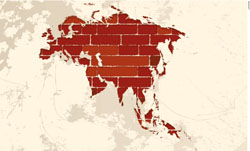ONE BELT ONE ROAD
RESURRECTING THE DAYS OF YORE
Zulfath Saheed gauges the potential reach of China’s Belt and Road initiative

China’s growing global influence was demonstrated in May when leaders from across the world assembled at the One Belt, One Road (OBOR) Summit held in Beijing. As part of the country’s foreign policy initiatives spearheaded by China’s President Xi Jinping, the event sought global cooperation on trade and infrastructure investments.
This would ‘open the world economy, rebalance globalisation and work toward trade liberalisation’ while serving to push for green and low-carbon development, it said.
India stayed away from the event citing concerns over OBOR-related developments in neighbouring Pakistan with whom it has had (and still has) longstanding territorial disputes.
Sri Lanka was represented by Prime Minister Ranil Wickremesinghe who noted that “it is important to establish peaceful non-military ties among the countries in the region. Therefore, it’s essential to establish multilateral trade ties” on a commercial basis.”
He pointed out that the Colombo International Financial City project would also fall under the ambit of the OBOR programme.
Sri Lanka’s inclusion in the OBOR initiative is not surprising given its oft-cited strategic geographic position. But the real impact of such a move has stirred up debate.

KEY COMPONENTS The initiative has been billed by Xi as ‘the project of the century’ and is said to cover slightly under two-thirds of the world’s population and 29 percent of global GDP.
Initially unveiled in 2013, the plan focusses on connectivity and cooperation between Eurasian countries – chiefly China – the land-based ‘Silk Road Economic Belt’ and the oceangoing ‘Maritime Silk Road.’
ANCIENT CORRIDOR The OBOR pays homage to the ancient Silk Road or Silk Route, which was a network of trade routes that were
central to cultural interaction for centuries. They originally encompassed the regions of Eurasia that connected the East and West, and stretched all the way from the Korean Peninsula and Japan to the Mediterranean Sea.
Trade on the Silk Road played a major role in the development of civilisations in China. While silk was the most imported trade item exported from China at the time, many other goods were also traded alongside religions, philosophies and technologies.
A maritime Silk Route is believed to have opened up around the 1st century, extending through ports on the coasts of India and Sri Lanka, to Roman-controlled lands in Roman Egypt and the Nabataean territories on the northeastern coast of the Red Sea.
LOCAL CONNECTION Sri Lanka’s strategic position at the centre of the maritime Silk Road affords an opportunity to promote the nation as a hub for trade in the Indian Ocean region.
This is believed to be the reasoning behind the administration’s efforts to support the OBOR initiative.
In the more recent past, China has emerged as one of Sri Lanka’s main trading partners and ranks among the leading five investors in the island. So the OBOR initiative is expected to strengthen trade and investment ties with China, as well as other nations that have signed up to the initiative.
But experts argue that countries like Sri Lanka may have limited opportunities to become part of the supply chain immediately as it would also require having the appropriate technologies, physical investments and human resources, which may or may not be provided as part of the OBOR plan.
SOUTHERN AGENDA The proposed economic zone in and around Hambantota has been cited as a means to actively participate in the OBOR with investments in the area enabling Sri Lanka to become part of the Asian supply chain and improve its economic model through technological advancement.
According to experts, goods manufactured in this economic zone could also be transported to the likes of Singapore through the maritime Silk Road and beyond via a proposed high-speed rail system.
FUNDING POLICIES A recent report by HSBC Global Research notes that China announced an additional US$ 136 billion in funding support for OBOR-related infrastructure projects in April. The report observes: “The Asia Development Bank (ADB) estimates that emerging Asia will require about US$ 22.6 trillion of infrastructure investment between 2016 and 2030, or US$ 1.5 trillion a year.”
“No single source of funding can meet the large demand. Given the vast and growing pool of long-term savings in Asia, money should not be an issue. The problem is matching these funding resources with investable projects,” it adds.
A key challenge for Sri Lanka then will be to call for a more detailed plan of the level of support rendered through the OBOR initiative to fully exploit its advantages and bolster the national economy in the longer term.




